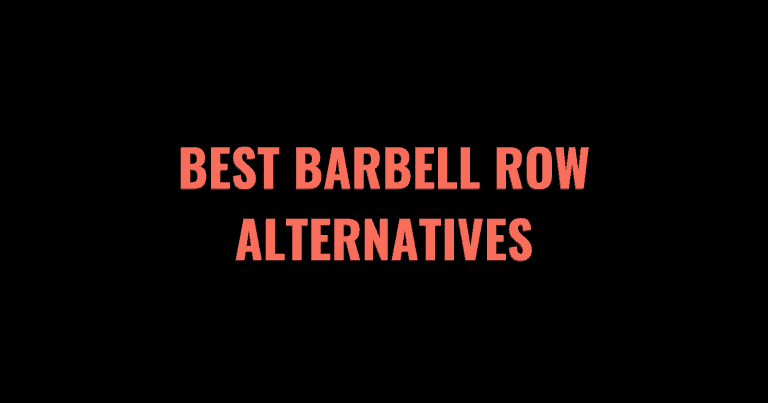The overhead press is one of the best exercises you can perform to build and strengthen your shoulders. It’s a compound movement that recruits multiple muscles, including the front delt, lateral delt, upper traps, triceps, and upper chest. The overhead press is also conducive to progressive overload, which is crucial for muscle growth.
With that said, the overhead press is not the only way to develop your shoulders. There are plenty of overhead press alternatives that can be utilized. Whether you can’t perform an overhead press or want to try out something new, we’ve created a list of the top 10 overhead press alternatives for you to choose from!
The exercises below were selected based on safety, effectiveness, and efficiency. Not only do we explain why each exercise is included, but we explain how to perform them correctly and provide some tips to get the most out of the exercise. If you want boulder shoulders, you can’t go wrong with any of the exercises in this article!
Table of Contents [show]
The 10 Best Overhead Press Alternatives
- Dumbbell Shoulder Press
- Machine Shoulder Press
- Arnold Press
- Smith Machine Shoulder Press
- Landmine Press
- Push Press
- Handstand Push-Ups
- Cable Shoulder Press
- Viking Press
- Front Raise
Dumbbell Shoulder Press
When to perform a dumbbell shoulder press
If you don’t have access to a barbell and a squat rack or experience discomfort performing a barbell overhead press, try a dumbbell shoulder press! This exercise is classified as a vertical pushing movement, so it recruits all of the same muscles as the overhead press; however, it’s a unilateral exercise.
Unilateral exercises allow your arms to move independently of one another, which helps correct and prevent muscular and strength imbalances from developing. If you’ve ever performed a pressing movement with a barbell and noticed one side of your body is much stronger than the other, start incorporating some unilateral work before you get injured.
The dumbbell shoulder press can be done seated or standing, try out both to see which one you prefer! You can even do them one arm at a time. Since this exercise primarily works the front and side delt, perform them near the beginning of shoulder-focused workouts.
These are also a great front delt dumbbell exercise.
How to perform a dumbbell shoulder press
- To do this exercise, you will need a pair of dumbbells and an adjustable bench.
- Adjust the bench to the highest setting, your torso should be as upright as possible during this movement.
- Grab a pair of dumbbells with a neutral grip, sit down on a bench, plant your feet on the floor, and position the dumbbells on top of your legs.
- Kick the dumbbells up to your shoulders, then your palms so they are facing outward. Your elbows and upper arm should form a 90-degree angle. This is the starting position.
- Take a deep breath, brace your core, and press the dumbbells overhead by extending your arms.
- Once your arms are straight, pause for 1-2 seconds, then exhale as you slowly lower the dumbbells back to the starting position.
- Repeat for the desired number of repetitions.
Check out the video below from Scott Herman to find out how to perform a seated dumbbell shoulder press correctly!
Dumbbell shoulder press tips
- Don’t let your lower back arch excessively as you lift the dumbbells overhead.
- At the bottom of the rep, don’t let your upper arms lower past 90 degrees to keep tension on the delts.
- You can do this exercise seated or standing. If you perform it standing, you will engage more of the core and glutes because they will be working to stabilize your torso.
Machine Shoulder Press
When to perform a machine shoulder press
A machine shoulder press is a great overhead press alternative for those that want to isolate their shoulders while limiting the involvement of other muscles. Most machines use a cable mechanism, which places constant tension on the delts, unlike free weights.
However, some gyms have a shoulder press machine that’s plate-loaded, mimicking free weights. Either way, there will be fewer stabilizer muscles recruited since you’re in a fixed path of motion, allowing you to strictly focus on the shoulders.
Some machines even allow you to train one arm at a time, so they can also be utilized to correct muscular imbalances. The machine shoulder press can be performed during shoulder workouts, push workouts, and upper body workouts. You can use it as an accessory exercise or primary movement.
For other great machines to train your shoulder muscles, check out our list of the best gym machines for shoulders.
How to perform a machine shoulder press
- Adjust the height of the seat so that the handles are at shoulder level.
- Depending on the machine, load or select an appropriate amount of weight.
- Sit down on the machine, plant your feet firmly on the floor, and reach up and grab the handles with a neutral or pronated grip. Your upper arms and elbows should be around a 90-degree angle.
- Slightly arch your back and bring your chest up. Don’t let your back excessively arch as you lift the weight upward.
- Take a deep breath, brace your core, and press the handles directly overhead by extending your arms.
- At the top of the rep, pause for 1-2 seconds, then exhale as you lower the handles back to the starting position.
- Repeat for the desired number of repetitions.
Watch the video below from Renaissance Periodization to see how to perform a machine shoulder press properly!
Machine shoulder press tips
- Keep constant tension on the shoulders by not letting the weight come all the way back to the resting position.
- Don’t excessively arch your back to lift the weight.
- Experiment with a neutral grip and pronated grip to see what feels best for you.
Arnold Press
When to perform an Arnold press
As the name implies, the Arnold press was invented by one of the most iconic bodybuilders of all time, Arnold Schwarzenegger. The Arnold press allows you to achieve a greater range of motion because you start with the dumbbells in a supinated position (facing you) and end with the dumbbells in a pronated position overhead.
Some people prefer this shoulder press variation because it places less strain on the rotator cuff and trains all three shoulder muscles (front, side, and rear delts) simultaneously. Another reason why the Arnold press is a good overhead press alternative is that it’s a unilateral movement.
Since you have to rotate the weight, you can only use dumbbells to perform an Arnold press. Therefore, each arm moves independently. This exercise will help you identify, correct, and prevent strength imbalances. The rotational aspect is also very beneficial for shoulder health and mobility.
We recommend performing the Arnold press towards the beginning of a shoulder-focused, push, or upper body workout. You can do this exercise seated or standing, but seated is the most common.
How to perform an Arnold press
- To do this exercise, you will need a pair of dumbbells and an adjustable bench,
- Adjust the bench to the highest setting so that your torso is as upright as possible.
- Grab the dumbbells with a neutral grip, sit down on the bench, plant your feet firmly on the ground, and place the dumbbells on top of your legs.
- Lean back and create a slight arch in your lower back. Then, kick the dumbbells up to shoulder level and rotate your hands so they are in a supinated position (facing you).
- Take a deep breath, brace your core, and begin to push the dumbbells over your head.
- At the halfway point, rotate your hands to a pronated position and fully extend your arms overhead.
- At the top of the rep, pause for 1-2 seconds.
- Exhale as you slowly lower the dumbbells back to the starting position. Remember to rotate your hands back to a supinated position.
- Repeat for the desired number of repetitions.
Colossus Fitness demonstrates how to perform the Arnold Press in the video below!
Arnold press tips
- Don’t let your lower back excessively arch as you press the dumbbells overhead.
- To engage your core more, do this exercise standing or seated without back support.
- Keep elbows slightly bent at the top of the rep to keep tension on the shoulders.
Smith Machine Shoulder Press
When to perform a smith machine shoulder press
A smith machine shoulder press is a common overhead press alternative because it allows you to focus more on the delts and less on stabilizing muscles. Not to mention, there are several spots where you can re-rack the bar on a smith machine, so you can safely train to failure without a spotter.
Some people prefer the smith machine shoulder press over a barbell overhead press because they don’t experience as much pain or wear and tear. Furthermore, some people lack the mobility to do a proper overhead press but can still train their shoulders with a smith machine press. This movement is also great for the upper chest since the bar path is more in front of you instead of directly vertical.
We recommend performing the smith machine shoulder press near the beginning of a shoulder, upper body, or push workout. You can bring the bar behind your head to hit the side delt more, but only if you have the mobility to do so. It’s more common to bring the bar to your collarbone as opposed to behind your head.
How to perform a smith machine shoulder press
- To do this exercise, you’ll need a smith machine and an adjustable bench.
- Place the bench in the middle of the smith machine and adjust it to the highest incline setting. Your torso should be as upright as possible.
- Place the bench to where the bar path goes directly in front of your face. Position the smith machine bar at a point where you can safely un-rack the bar with a slight bend in your elbows. Load an appropriate amount of weight on each side.
- Sit down on the bench, extend your arms overhead and grab the bar with a shoulder-width pronated grip (palms facing out). Place your back and head against the support pad and create a slight arch in your lower back.
- Unrack the bar by lifting slightly up and rotating the bar forward or backward, depending on the machine.
- Take a deep breath and begin to lower the bar towards the top of your chest.
- Once your upper arm and elbow form a 90-degree angle, pause for 1-2 seconds.
- Exhale as you push the bar overhead and stop just before lockout to keep tension on the shoulders.
- Repeat for the desired number of repetitions.
Watch the video below from Renaissance Periodization to find out how to set up and perform the smith machine shoulder press!
Smith machine shoulder press tips
- Stop just before lockout to keep tension on the shoulders.
- The bar should be as close to your face as possible.
- Don’t excessively arch your lower back while pressing the weight up.
Landmine Press
When to perform a landmine press
The landmine press is a more functional overhead press alternative. Landmine presses improve shoulder strength, mobility, and stability. They can be performed with both arms at once or one arm at a time. Even if you only have access to a barbell, you can still do some unilateral work to prevent strength imbalances from developing.
Although the name implies that you need a landmine to perform this exercise, that’s actually not the case. All you need is a corner to place one end of the barbell in. Whether that’s the corner of a wall or the corner of a squat rack, either will work! This exercise is very home-gym friendly since most people at least have access to a squat rack and barbell.
Since the landmine press is a compound movement that requires a lot of stability, we recommend performing this exercise near the beginning of your workout. If you do this exercise one arm at a time, start with your weaker side, then match the number of reps and weight you do with the stronger side.
How to perform a landmine press
- To do this exercise, all you need is a barbell. If you have access to a landmine, use it, but it’s not mandatory.
- Place one end of the barbell in a landmine or in the corner of a squat rack or wall.
- Load an appropriate amount of weight on the other end of the barbell.
- Assume a shoulder-width stance with your toes slightly pointed out. Reach down and grab the end of the barbell with your left hand using a neutral grip.
- Bring the end of the barbell up to your left shoulder. Lean slightly forward so that your body is more in line with the path of the barbell.
- Take a deep breath, brace your core, and push the barbell upwards until your arm is fully extended overhead.
- At the top of the rep, pause for 1-2 seconds, then exhale as you slowly lower the barbell back to your left shoulder.
- Repeat for the desired number of repetitions, then switch arms.
In the video below, Alex Simone demonstrates how to properly execute the single-arm landmine press!
Landmine press tips
- At the top of the rep, it may be easier to get a full extension by leaning forward slightly.
- Squeeze your glutes and tighten your core to increase overall stability.
- Start with your weaker arm and match the weight and number of reps you do with the stronger arm.
Push Press
When to perform a push press
A push press is similar to a barbell overhead press, except that you’re using your lower body to gain momentum, allowing you to lift more weight. A push press is most commonly performed in CrossFit and Olympic weightlifting. However, it’s not the same as the jerk.
If you’ve hit a plateau on the strict overhead press, incorporating the push press may be what you need to hit a new personal best. The push press will allow you to lift more weight compared to an overhead press, which should lead to strength gains in the front and side delts.
Not to mention, the push press has great carryover to the overhead press, so it’s an excellent alternative if you can’t progress on the overhead press no matter what you try. The movement allows your shoulders to get used to heavier weight by using momentum to get the weight overhead, then controlling it on the way down.
Since the push press is a demanding compound exercise, perform it near the beginning of the workout when you’re the freshest.
How to perform a push press
- To do this exercise, you will need a squat rack, Olympic barbell, Olympic plates, and weight clips.
- Adjust the height of the squat rack so the barbell is just below shoulder level. Place the barbell on the rack, load an appropriate amount of weight on both ends, and attach the weight clips.
- Stand facing the barbell and assume a shoulder-width stance. Bend your arms with your palms facing away from you, and grab the barbell just outside of shoulder width.
- Unrack the barbell by standing straight up, lifting the barbell with your hands, and taking 2-3 steps backward. The barbell should be resting at shoulder level.
- Take a deep breath, perform a quarter squat, then explode up. Use the momentum from the concentric portion of the squat to push the barbell overhead simultaneously.
- As you approach the lockout, bring your head slightly forward to complete the rep.
- At the top of the rep, pause for 1-2 seconds, then exhale as you slowly lower the barbell back to your shoulders.
- Repeat for the desired number of repetitions.
Watch the video below from the Buff Dudes to see how to correctly perform a barbell push press!
Push press tips
- Flat-soled shoes work best for this exercise.
- As you lift the barbell up, move your head slightly back to allow for a more vertical bar path. At the top of the rep, move your head forward to return to neutral.
- Control the weight on the way down as much as possible. By controlling the weight, you’ll see more carryover to other overhead press variations and greater hypertrophy.
Handstand Push-Ups
When to perform handstand push-ups
Handstand push-ups (HSPU) were made famous by gymnasts and later adopted by CrossFitters. They are one of the best exercises you can do for the shoulders if you have the skillset, mobility, and strength to perform them correctly.
Fortunately, there are several ways to scale down the difficulty! Even if you can’t do an official handstand push-up, you can still get similar benefits by making a few tweaks to the exercise.
You can also make the exercise more difficult by increasing the range of motion. This is most commonly achieved by performing the exercise using parallette bars. Oftentimes, you’ll see CrossFit competitors do kipping handstand push-ups, which means they use momentum to help them get more reps.
Since most of our readers are more concerned with gaining strength and muscle, as opposed to getting a certain number of reps within a given time frame, we recommend sticking with strict handstand push-ups.
One major benefit to this exercise, besides its scalability, is that you need minimal equipment, and it can be performed nearly anywhere! Whether you’re at home, at the gym, or traveling, you can still train your shoulders with this exercise!
How to perform handstand push-ups
- Place a mat or pad next to a wall.
- Assume a shoulder-width stance facing the wall.
- Perform a handstand by planting your hands on the ground approximately 6 inches away from the wall and just outside of shoulder width.
- Kick your legs up until your heel makes contact with the wall. Tighten your core and squeeze your glutes so your body remains as vertical as possible.
- Take a deep breath, then begin to lower your head to the floor by bending your arms.
- Once your head touches the floor or pad, pause for 1-2 seconds.
- Exhale as you push through the psalm of your hands to straighten your arms and return to the starting position.
- At the top of the rep, hold for 1-2 seconds, then repeat for the desired number of repetitions.
In the video below, they run through all of the handstand push-up variations you can do depending on your experience level!
Handstand push-up tips
- If you can’t do more than 1-2 handstand push-ups with the correct form, try some of the other variations highlighted in the video above.
- Maintain a neutral spine by tightening your core and glutes throughout the movement.
- To make the movement easier, use a thicker pad to reduce the range of motion. As you get stronger, you can switch to a thinner pad/mat.
Cable Shoulder Press
When to perform a cable shoulder press
The cable shoulder press is more of a hypertrophy-focused exercise because the cable places constant tension on the delts, but it doesn’t lend itself to heavy strength training. If your goal is shoulder hypertrophy, the cable shoulder press might be a better alternative to the traditional overhead press.
What’s more, the cable shoulder press is a unilateral exercise that improves the symmetry of your physique and correct strength imbalances.
The cable adds an element of instability because it’s more difficult to balance than free weights. Your body will be forced to recruit more muscle fibers as you fatigue from trying to perform the exercise and maintain stability.
The cable overhead press can be performed seated or standing and one arm at a time or both arms at once. Depending on your cable machine, the set-up will vary but overall the exercise instructions below remain consistent.
How to perform a cable shoulder press
- Place an adjustable bench in the middle of a cable stack. The cables with the pulleys closer together work best.
- Position both sides of the cable pulleys to the lowest setting, attach a D-handle to both sides, and select an appropriate amount of weight.
- Grab the handles with an underhand grip with your palms facing outward and bring the handles to shoulder level.
- Sit down on the bench, rest your head and back on the support pad, and plant your feet on the floor. Your upper arms should be at approximately 90 degrees.
- Take a deep breath, brace your core, and lift the cables overhead by extending your arms.
- Once your arms are fully extended, pause for 1-2 seconds, then exhale as you slowly lower the cables back to the starting position.
- Repeat for the desired number of repetitions.
Check out the video below from My PT Hub to see how to perform a standing cable shoulder press!
Cable shoulder press tips
- If you perform this exercise standing, maintain a neutral spine by bracing your core and squeezing your glutes.
- Keep tension on the delts by stopping just before full extension at the top of each rep.
- If you perform this exercise seated, create a slight arch in your lower back but don’t let your back excessively arch as you press the cables overhead.
- At the start of each rep, squeeze your shoulder blades together.
Viking Press
When to perform the Viking press
The Viking press is a variation of a military press that’s extremely popular among strongman competitors. You can perform this exercise using barbells and a squat rack, which is highlighted in the video below. But it’s most commonly performed using a Viking press machine that’s plate-loaded and requires little to no set-up.
Most Viking presses feature a neutral or parallel grip, which may be easier on the shoulders for some people compared to traditional overhead pressing. The Viking press machine is a handle attached to a straight lever, which is attached to a fulcrum at about chest level.
Instead of moving straight up and down, the handles move in a slight arc, making it a hybrid between the overhead press and landmine press. Most Viking press machines even have a built-in safety mechanism to allow you to train to failure without worrying about dropping the weights. If you experience shoulder or wrist discomfort with a barbell overhead press, then try out the Viking press to see if that alleviates your pain!
It’s a good idea to perform the Viking press near the beginning of a shoulder-focused workout since it’s a major compound movement.
How to perform the Viking press
- Adjust the height of the Viking press so that the handles are at shoulder level. Load an appropriate amount of weight on each side of the machine.
- Face the Viking press and assume a shoulder-width stance with your toes pointed slightly out.
- Grab the handles using a neutral or pronated underhand grip (whichever feels most comfortable to you).
- Squeeze your glutes, tighten your core, and take a deep breath.
- Push the weight overhead by extending your arms straight up and slightly forward.
- At the top of the rep, pause for 1-2 seconds.
- Exhale as you lower the handles back to the starting position.
- Repeat for the desired number of repetitions.
In the video below, Bret Contreras goes over the set-up, benefits, and how to properly perform a Viking press!
Viking press tips
- Keep your core and glutes tight to maintain a neutral spine throughout the movement.
- Don’t completely lockout at the top of the rep to keep tension on the delts.
- Experiment with the grips to see what feels best to you.
- At the start of each rep, squeeze your shoulder blades together.
Lateral Raise
When to perform a lateral raise
The last exercise we are going to mention in the best overhead press alternatives list is the lateral raise. Compared to all of the exercises we’ve covered so far, the lateral raise is the only isolation movement.
Since the overhead press primarily works the front and side delt, you could argue that a front raise should also be included in this list. However, the front delt is typically overdeveloped, whereas the side and the rear delts are underdeveloped in comparison.
Even though the side delt is active during an overhead press, it would benefit from direct training which is why the lateral raise is often added to various programs. If you want three-dimensional-looking shoulders, training your side and rear delts is paramount.
A lateral raise can be performed at any point during a shoulder-focused workout because it’s not nearly as taxing as a compound movement. You can perform this exercise with dumbbells, cables, kettlebells, or resistance bands. In the example below, we’re going to cover the dumbbell variation.
How to perform a lateral raise
- Grab a pair of dumbbells with a neutral grip.
- Stand tall with your feet approximately shoulder width apart. Allow the dumbbells to rest at your sides.
- Take a deep breath, brace your core, and begin to raise the dumbbells up and out to the side. Focus on leading with your elbows as opposed to your hands. There should be just a slight bend in your arms at all times.
- Once your elbows or the dumbbells align with your shoulders, pause for 1-2 seconds and focus on squeezing the side delt.
- Exhale as you slowly lower the dumbbells back to the starting position.
- Repeat for the desired number of repetitions.
In the video below, Jared Feather from Renaissance Periodization demonstrates how to perform a dumbbell lateral raise!
Lateral raise tips
- To maintain constant tension, use cables instead of dumbbells.
- Avoid using momentum to lift the dumbbells.
- Control the weight as much as possible on the way down.
- Drive with your elbows. They should always be higher than your wrists.
Reasons to choose an overhead press alternative
The overhead press is one of the best exercises you can do to increase the size and strength of your shoulders. With that said, some people struggle to perform an overhead press correctly due to a lack of mobility and/or pain. Fortunately, you can still build impressive shoulders without having to do a barbell overhead press.
There are several exercises, such as the ones listed above, that you can do as an alternative. As long as you are performing a vertical pressing motion, your front and side delts will be challenged. Beyond experiencing pain or having poor mobility, you may not be able to perform an overhead press because you’re limited on equipment. On the other hand, maybe you’ve been doing an overhead press for an extended period of time and reached a hard plateau.
Lastly, what if your front delts are overpowering, but your side and rear delts could use some more work? Continuing to do an overhead press will exacerbate your muscular symmetry issue. In this case, performing isolation exercises, such as rear delt fly or dumbbell lateral raise, are better options. As you can see, there are numerous reasons why you may choose to do an overhead press alternative.
Muscles worked by an overhead press
The overhead press primarily works the shoulder muscles, including the front delts and side delts. It also engages the triceps, upper chest, and upper traps. The forearms, core, and glutes are activated as stabilizer muscles.
Primary Muscles
- Deltoids
- Front (anterior) delts
- Side (lateral) delts
Secondary Muscles
- Chest
- Pectoralis major (upper fibers)
- Triceps
- Lateral head
- Medial head
- Long head
- Traps
- Upper trapezius
- Core
- Stabilizer muscle
- Glutes
- Stabilizer muscle
- Forearms
- Stabilizer muscle
Frequently asked questions
When performed correctly, the overhead press is not considered to be bad for your shoulders. If you experience shoulder impingement during an overhead press, you should stop and reassess your form and technique.
You may need to work on improving your shoulder mobility by drastically ramping up the intensity on the overhead press. You can also experiment with different grip widths, elbow positioning, and ranges of motion to see what feels most comfortable.
The overhead press is a very effective mass and strength-building exercise, but it’s not necessary for shoulder hypertrophy. As long as you are performing a vertical pressing motion (i.e. machine shoulder press, Viking press, etc.), you will sufficiently target the side and front delts.
However, isolation exercises, in addition to vertical pressing, are an excellent idea to target all three heads of the delt effectively. No matter what exercise you’re performing, focus on perfecting your form, feeling the muscle work, and increasing weight and/or reps over time. Progressive overload is the key to increasing strength and muscle mass.
Key Takeaways
The overhead press is a staple exercise for many gym-goers, and for a good reason. The overhead press is a functional compound movement that targets multiple muscle groups, most notably the shoulder muscles. It’s especially effective at increasing shoulder strength and size while improving shoulder stability.
Even though it’s a very good exercise, the overhead press is not a mandatory exercise. Regardless of why you can’t perform an overhead press, or want to seek an alternative, there are several exercise replacements that can be utilized instead.
The key to growing any muscle is doing an exercise with proper form and progressing over time, whether that be by adding reps, sets, weight, or improving your form. There’s no exercise that has to be performed in order to maximize your physique. If you need an overhead press alternative, try out some of the best ones listed above!
Other Alternative Exercises
If you enjoyed this post, check out our other roundups of the best alternatives for other exercises.














